Karelian Bear Dogs are a primitive hunting breed known for their courage to deal with large prey animals, including bear and cougar. Believed to have survived to the present day from descendants of Viking Age spitz-type hunting dogs, the qualities that are necessary for survival in the wilderness have been passed on to the present generation. Fearless by nature, the dog is known for its ability to work independently in difficult conditions.
As remarkable as their natural beauty and athleticism is their capacity to make wonderful companion dogs. Because of their high energy and intelligence, they are best suited for an experienced dog handler.
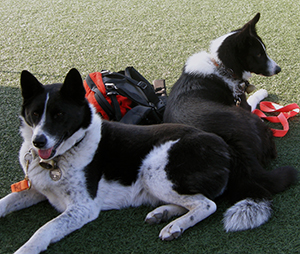
Not immediately friendly with strangers, they are best handled by immediate family members. Yet, once California Karelians'Star had reached her destination during a hike in the mountains, she couldn't resist giving a kiss to her hiking companion.

Appearance
The Karelian Bear Dog (or KBD) is an extremely attractive medium-sized dog. The Karelian Bear Dog is considered a member of the spitz family of dogs, which refers to dogs generally characterized by: long, thick fur; pointed ears and muzzle; and a tail that is curled over the dog's back.
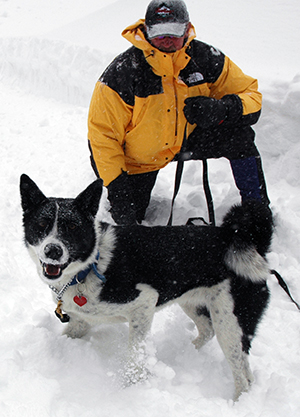
The Karelian Bear Dog breed standard became recognized by Scandinavian and Finnish kennel clubs in 1946. At the withers, Karelian Bear Dog males are generally 21 to 23-1/2 inches and the females 19 to 21 inches. Karelian Bear Dogs look like a typical Nordic Spitz, with small prick ears and a tail that curls over the back. The ears are cocked and point outward slightly. They are lined with dense fur reducing the risk of frost bite. The head is wedge-shaped with a broad backskull. The short-haired all-weather coat consists of straight, stiff hair while the under-layer is soft and dense. The thighs are covered in thick hair. The KBD has a wide chest and is moderately angular in the rear. Today's breed standard calls for a black-and-white dog whose white markings are found in varying amounts on the head, neck, chest, abdomen and legs. A copper tint is common. Black speckles in the white are considered a fault. The nose is black, and the small dark eyes are very expressive. The tail is long and curls over the back in a typically Spitz arch. Robustly built, well-boned and of moderate size, the Karelian Bear Dog is slightly longer than he is tall. The body is sturdy and the back is well developed.
True working partners
who possess a special athleticism
Beyond the sheer determination and enthusiasm that a Bear Dog will exhibit, its athletic skill is difficult to adequately describe in words. They can jump straight up in the air, so fast you'll hardly see it happen. They will climb a tree if that will give them the vantage point they want. In an all-out run, they will suddenly turn with phenomenal quickness. Opportunists, they will cleverly figure out how to open the door to their kennel. Off leash, their natural tendency is to circle around you, checking out the perimeter for unwanted predators.

Communicative interaction between human and Karelian Bear Dog occurs as the Karelian looks to you to receive its mission. Then, the dog will instinctively proceed to accomplish that mission without the need for--or expectation of--further instructions.
Their intelligence should be respected, as Karelian Bear Dogs are true working partners.
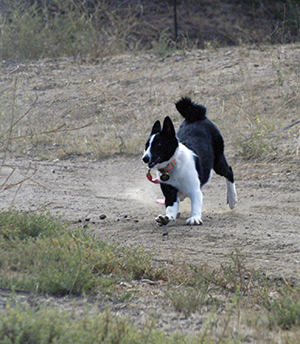
I would not describe a KBD as difficult to train, because with the proper handling, they learn very quickly what it is you want them to do. They will test your dog handling skills because they want to be challenged and will often be one step ahead of you in their thinking if you do not watch your dog and anticipate its next move. After you have communicated what you want them to do, Karelian Bear Dogs will not look back to you for help when faced with an obstacle to their success, as many other dog breeds will do. The Karelian will think through the problem on its own to reach its ultimate destination and reward.
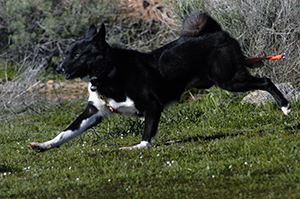
A primitive dog, not like other dogs
Karelian Bear Dogs (KBDs) are a primitive dog that for millennia survived the harsh continental climate of the taiga zone of northeastern Europe, just below the tundra. Centuries ago, primitive hunting dogs made man's survival possible, providing meat for their families and pelts that could be traded for essentials such as flour, gun powder, and tea. In appearance, Karelian Bear Dogs exhibit traits of the native dogs of Finland, Karelia and northeastern European Russia. Karelia, after whom the dogs are named, is the land of the Karelian people, a vast area in northern Europe of historical significance for Finland, Russia and Sweden.
Karelian Bear Dogs were imported relatively recently to the United States and Canada. Most of the Karelian Bear Dogs bred in the United States are descendents from the KBDs and RELs that were brought to this country around 1991 by Dr. Shushanov. Names of his dogs can be found in pedigrees of many lines of KBDs now living in the United States. Offspring from Dr. Shushanov's breedings were registered as KBDs with the Universal Kennel Club, one of America's oldest and most respected kennel registeries.
Keen hunting instincts come naturally
Cynology (the study of dogs) tells us that the Karelian Bear Dog that survives today is believed to have 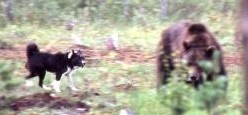 descended from ancient spitz-type hunting dogs. Below, coveted for its hunting abilities, the Karelian Bear Dog possesses unyielding bravery and determination, fearless by nature, unyielding of an oncoming threat. descended from ancient spitz-type hunting dogs. Below, coveted for its hunting abilities, the Karelian Bear Dog possesses unyielding bravery and determination, fearless by nature, unyielding of an oncoming threat.
The Karelian Bear Dog was historically used mainly for hunting small fur-bearing animals, such as squirrels and marten. Like the Norwegian Elkhound, the Karelian Bear Dog was also used in hunting moose, lynx, wolf and, as its name would suggest, hunting the Eurasian brown bear (a bear species as large and aggressive as the American Grizzly). Traditionally, common types of working trials for the Karelian Bear Dog have included moose hunting trials, bear hunting trials and bear instinct trials.
At California Karelians, we are showing that the confidence, drive and intelligence that distinguish this breed can be directed in many outdoor recreation and wilderness activities, from hiking and camping to agility and K9 search and rescue.
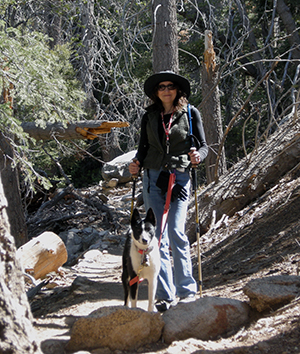
Family Companion Dogs
A KBD will alert at the appearance of large predators, making them a welcome companion on hikes and fishing or camping trips. Below, California Karelians' Shasta at six months old goes fly fishing on the Yellowstone River.
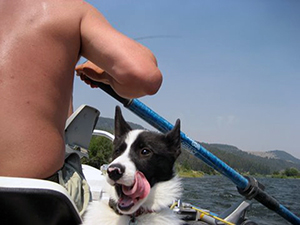
As remarkable as the KBD's instincts for wilderness large predator protection and hunting is their capacity to make wonderful family dogs. Starting at just a few weeks of age, it is clear that the Karelian Bear Dog is a discerning dog, not immediately friendly with strangers. Yet, Karelians are instinctively gentle with children and will bond remarkably quickly to a new owner.
Throughout history Karelian Bear Dogs were the dogs of peasants and hunters who did not tolerate dogs attacking farm animals. Therefore, these dogs easily learn to distringuish outdoor prey and family pets. California Karelians are raised with CaliMaine's Maine Coon cats, and we socialize our dogs and cats by intentionally enouraging our kittens and Karelians to interact, beginning at a young age.
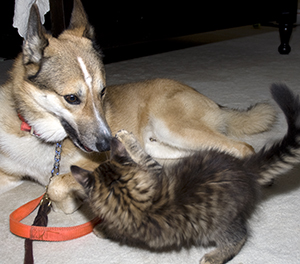
Below, California Karelians Shasta romps with her new canine family member.
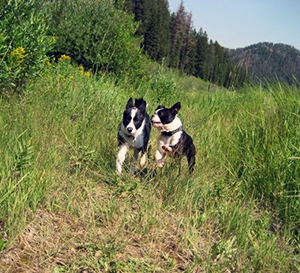
We at California Karelians live with KBDs indoors and out. This breed does need exercise and time to freely interact with its surroundings to stay healthy mentally and physically. Yet our Karelians are as eager to be with us as our Border Collie, enjoying opportunities to follow us around the house or lie next to us when relaxing in the evening.
Faithful Protectors
Karelian Bear Dogs are known for their devotion to their masters and will fearlessly protect their home and family. Karelians are faithful to those they believe to be their "family." As close as the young adults become to us as their first handlers, they make an easy transition to a new "family", easily assuming the role of protector.
Below , we brought California Karelians' Snowflake along to a kitten wellness visit with our vet, and he made certain the health professionals took good care of his kitten.
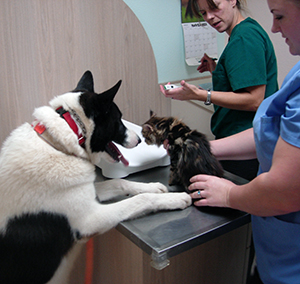
Training a Karelian Bear Dog
Karelian Bear Dogs do well with an experienced handler, but because of their intelligence and quickness, we do not recommend them as a first dog. Raising your voice at Karelians
will not engender increased compliance, but instead, have the opposite effect. They are not a dog that can be dominated through anger.
You will want to communicate your expectations during dog obedience training. Training should usually be performed in a variety of environments, particularly those that are representative of the types of environments in which your dog will be spending time with you.As with any breed, obedience training should be started early to help ensure the dog's safety and your enjoyment of this remarkable breed. Below, Karelians of various ages are practicing a long stay under the challenges of distance, duration and distraction.
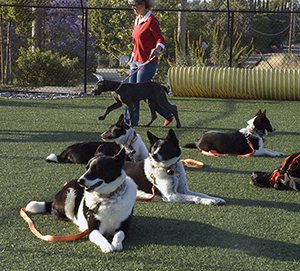
The American Kennel Club's Canine Good Citizen® program is one way to learn--and demonstrate your success with--basic training for your Karelian and can help you lay the foundation for more specialized training with your dog, such as obedience, agility, tracking, and performance events.
We encourage you to consider for yourself whether this breed of dog will be suitable for your household. We are happy to discuss your aspirations for owning one of these wonderful dogs; feel free to contact us. |